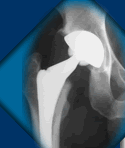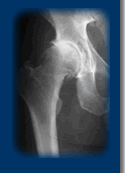Computer-assisted surgical navigation of the partial and total knee
replacement is a relatively new field. The technique can be combined
with minimally-invasive surgical techniques both optimize
accuracy of knee replacement while making recovery somewhat
faster and easier. Computer-assisted knee replacement
is identical to traditional total knee replacement in many
ways and fundamentally different in a few others. Traditional
knee replacement surgery and computer-assisted, surgically
navigated knee replacement surgery both involve making an
incision over the front of the knee and implanting knee
replacement components.
Traditional knee replacement surgery and surgically
navigated knee replacement surgery differ really in
the method of determining the size and location of the implants and associated alignment and ligament balance
of the knee.
Computer-assisted surgical navigation involves fixing reference
frames to the femur and tibia. Reference frames are shaped
a bit like small starfish and are temporarily fixed to the
bone with small pins. An infrared stereoscopic camera can
follow the movements of the reference frames so that the surgeon
knows exactly where the femur and tibia are during surgery.
The positions of all of the important surgical instruments
can also be tracked by the camera. Knowing where the position
of the surgical instruments compared to the bones during surgery
allows the system to make accurate calculations about all
of the important aspects of knee replacement surgery including
size, position, alignment, motion, and ligament balance.
Computer-assisted surgical navigation allows for total
knee replacement to be performed without drilling a hole in
the end of the femur and pushing a metal rod into the femur
to gauge alignment the way that traditional total knee replacement
surgery does. It is very likely that studies will show that
elimination of this rod in the femur will drastically reduce
the incidence of micro-embolism of bone marrow, air, and fat
during total knee replacement surgery. Micro-embolism is often
a subtle problem that can cause temporary confusion and mild
breathing trouble after surgery. Occasionally the problem
can be more serious, especially if two knees are replaced
at the same time. There are few, if any, additional risks
with these techniques. However unlikely, it is theoretically
possible that if a patient fell early after surgery, that
person’s tibia or femur could crack through one of the
small pin holes in the bone used to fix the reference frames.
This was reported in one case performed in Europe in the past.
What we do know is that the system can objectively track range
of motion, ligament balance, and limb alignment more accurately
than any surgeon can gauge on his own.
Dr. Murphy has performed more than 400 partial and total knee arthroplasties
and this represents one of the longest and largest series
of computer-assisted total knee arthroplasty in the United
States. He also performed the first computer-assisted total knee arthroplasty in New England (May of 2002) and is the immediate past president and executive board member of the International Society for Computer Assisted Orthopedic Surgery. It is clear that these methods are efficient, accurate,
and as safe or safer than traditional methods. More information
about computer-assisted surgical navigation for total knee
replacement surgery can be viewed on the links below.
Note: You must have Adobe Reader to save PDFs to
your personal computer and to print them.

|



